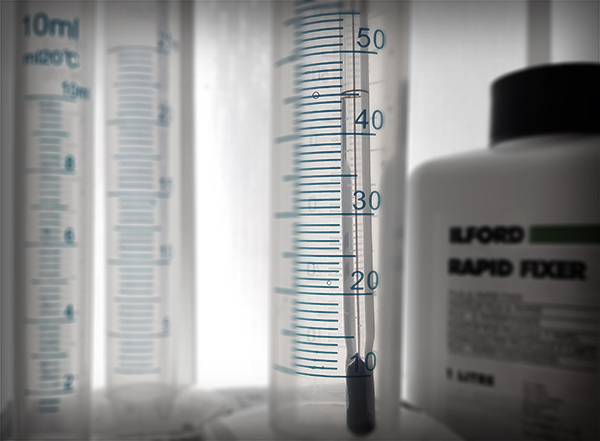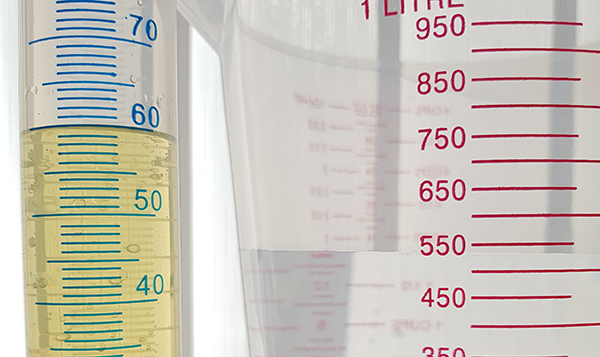How to mix photo chemicals

Mixing photographic chemicals is quite straight forward as long as you follow the method detailed below.
Health and Safety
If you are at all sensitive to chemicals or have allergies that might be triggered by handling chemicals or breathing in powder form chemicals, please seek advice from your medical professional before handling photo chemicals/materials and always take full precautions. Precautions:- Wear surgical gloves to protect your skin
- Wear a surgical face mask when handling powders
- Wear safety glasses to avoid splashes reaching your eyes and mouth
- Wear an apron to protect your clothing
- Mix all chemicals in a well ventilated area
- Clean up any spillages immediately with plenty of water
- Dispose of bottles or packaging in a responsible manner
Chemical types and forms
Commercially produced photographic chemicals usually come in either concentrated liquid in bottles or a crystal/powder mix in packets.
Liquid Concentrates The liquid concentrates are usually diluted directly with water as they are needed to make the 'working solution' ready for use. The commonest photo chemicals bought as liquid concentrates include:
- Film and paper developers
- Stop baths
- Fixers
- Wetting agents.
Powder Chemicals Before they can be used the powder variety first need to be mixed with water to produce a 'stock solution'. This first step with the powder chemicals converts the powder into a 'concentrated solution' similar to the ready mixed bottled types. When preparing the stock concentrate from powder e.g. Ilford ID 11 film developer, use water at around 40 degrees C to help the powder crystals dissolve easier. In the case of Ilford ID 11 film developer and usually other brands too, once mixed as a 'stock' the chemical can either be used full strength direct from the stock solution or further diluted with water to make a 'working solution'.
Important: Always consult the manufacturer's product information for specific details of how to handle and mix a particular photographic chemical.
Diluting concentrated chemicals Concentrated liquid photo chemicals, and 'stock' from powder, usually require mixing with water to make the 'working' solution.The proportions of concentrated chemical and water are mixed in 'parts' to produce the required 'dilution'. The dilution is usually shown as two numbers with a 'plus' sign between them like this: 1+3.
The first number is the amount or 'number of parts' of concentrated chemical and is usually 1 meaning 1 part. The second number is the number of 'parts' of water required to complete the mix. For example, a dilution of 1 + 3 means 1 part chemical concentrate to 3 parts water.
When we talk about dilutions we usually say things like "1 to 3" or "1 to 0" (this latter simply means use the stock solution without adding more water. ID 11 is often used direct from stock since the stock can be replenished for economy.)
To work out the quantities of each 'part' for a specific mix, add the dilution numbers together to obtain the total number of parts needed (e.g. 1 + 3 = 4) and divide this total into the quantity of working solution needed for your film tank.
As an example, the Paterson tanks require a minimum of 290ml of working solution to process one 35mm film so let's round this upto 300ml to make things easier.
To make 300ml of working solution with a chemical that needs to be mixed at 1 + 3 (total of 4 parts), one part would equal 300/4 = 75ml. So the 'working solution' would need one part (75ml) of chemical concentrate mixed in three parts (225ml) of water at 20 degrees C.
Important: Always add the chemical concentrate to the water and NOT the water to the concentrate. This is standard lab procedure.
Stir the solution gently to completely mix it.

Another example, say your print developer info tells you it should be diluted 1 + 9 and you want to make a working solution of 600ml, then you would add the dilution numbers together (1 + 9 = 10) and divide 600 by this number to find the quantity of '1 part'. In this example, 600/10 = 60, so we need 1 part (60ml) of print developer and 9 parts (9*60 = 540ml) of water to obtain the 1 + 9 working solution.
Temperature of chemical solutions
Most black and white chemicals are manufactured to give optimum performance at the traditional temperature of 20 degrees Centigrade (68 degrees Fahrenheit).
If the temperature is higher than 20C the chemical will usually be more 'active' and if the temperature is lower less active.
To compensate for this change in activity, most manufacturers provide a Time/Temperature chart which tells you how much adjustment may be required for different temperatures.
However, in the case of developers (both film and paper but more so with film) the effect on the emulsion may change at different temperatures. For example, using a higher temperature with film development may result in larger grain in the final negative. Also, higher temperatures require shorter times which if too short could lead to uneven development of the film. These issues are less important with paper developers except to say that if the temperature of the paper developer is too low there may not be enough 'activity' to produce the best black the paper is capable of.
Unless there are unusual circumstances or you are looking to explore a creative effect, my advice is always to use the chemicals at the standard 20 degrees C (68 degrees F) for consistency and performance.